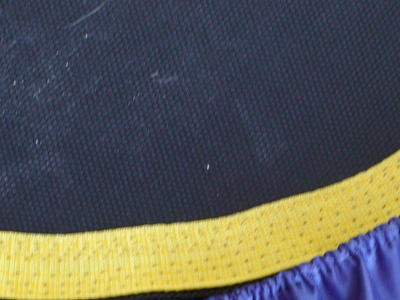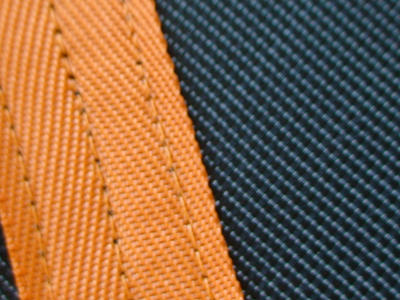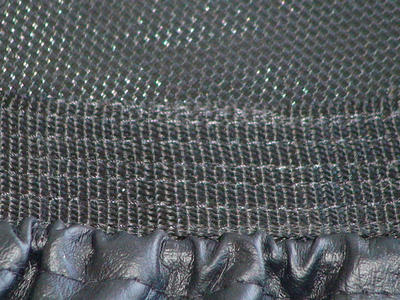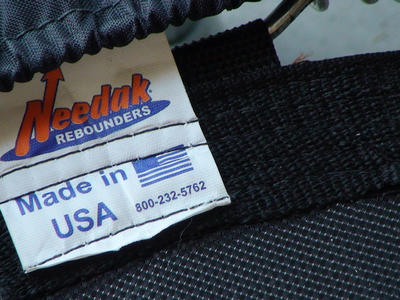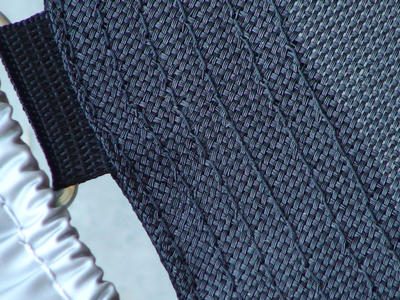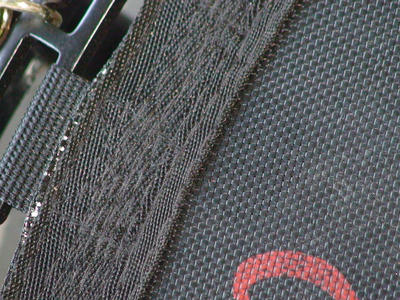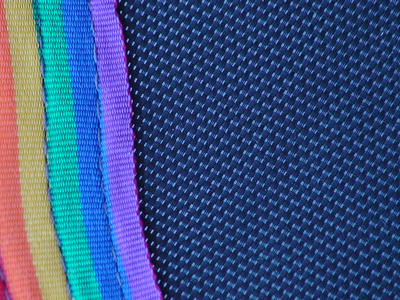Mat Testing:
All mats will stretch over time.
The question is... how much time!
The mats ability to resist stretch is directly related to the types of springs.
A good mat with cheap springs is like putting expensive tires on a run down car.
Avoid nylon mats...they stretch more than any other mat besides canvas mats.
Canvas mats tend to rot and rip the most.
If you have knee, back, or hip problems AVOID canvas.
If you are going to rebound outside in the sun, avoid blue Permatron mats.
These do not have the UV ratings as the black mats.
Blue mats wear out faster and stretch out quicker.
Always make sure that the stitching is seared together to avoid "running" of the threads.
Cheaper mats do not have seared stitching.
Some companies sear their threads because they have a "running" problem.
Permatrons mats are good. Seared Permatron stitched mats are the best.
The best threading is 4 Ply polyester thread.
Always get the highest grade Permatron for a rebounder if you want it to last a long time.
Fuzzy Prevention:
Wanna stop getting fuzzies on your mat and stop the mat from "fraying"?
Better stitching that is seared will stop the mat from breaking down prematurely.
Mats srtetch because there is not enough "tensile resistance".
Permatron has the most resistance.
Since Permatron mats do not stretch, they will not throw you off balance and will give an "upward" lift since it doesn't cave in like other mat materials.
Always go for 4 Ply polyester thread instead of nylon or vinyl stitched mats. (Note: High quality mats do not create a lot of static like other mats. On some rebounders, when my dog gets on it, I can't even touch him without shocking myself and the dog, especially when used on carpets. I have noticed that leaving rebounders out in the rain helps get rid of this static but if the stitching and mat is not protected the mat can dry out and doesn't feel good to the feet like a fresh one.
Mat Tip:
Mats made with Permatron will NOT stretch. Since they do not stretch, it will not throw you off balance and will give an "upward" lift since it doesn't cave in like other materials. Always go for a 4 ply polyester thread instead of nylon stitching.
A good mat has double or triple stitched edges so the hooks never rip through the mat or stretch out giving uneven mat tension. A good mat lets you land on the mat where the majority of your weight deforms the surface of the mat as your body never stops in a sudden force at the bottom. The milliseconds that each type of spring lets your body go down to deform the complete surface of the mat makes the difference in the feel of one rebounder to another. All the springs working synergistically cause this feel.
Take the rebounder quiz to see which rebounder is best for you.
A final word on mats:
When something is known for stretching, there is no limit to how much it can stretch. Eventually it will have to be replaced. The idea of picking the perfect rebounder is getting as little maintenance as possible and still getting the same results as when you first purchased your new rebounder. Vinyl and nylon mat threading, though very functional, in my opinion would need to replaced a lot sooner than something more durable and sturdy such as polyester. Most rebounder companies have switched over to polyester threading with Permatron mats. Look for mats with at least two or more ply stitching.
If you are the type that has balance problems, you don't want a mat that is very firm around the edges and really soft in the middle. If I don't space my feet equal distance apart, such as having one foot near the edge and one foot in the middle, it can throw me off.
The bigger the "sweet spot" the more stable the rebounder feels to me. Some rebounders invert my ankles from the "cone" shape it makes when you jump on it. If you don't mind wearing special running shoes for pronation you can get away with it or better yet, buy a rebounder that doesn't do this. I prefer rebounders that do not have a drastic drop-off from the firm edge to becoming really soft towards the center. We used bowling balls to show how dropping the ball in different spots of the rebounder gave higher or lower bounces. Having one foot on a firm spot and one on a significantly softer spot is what we try to avoid.
Compare the top Lymphatic Rebounders
New Zealand lymphaciser VS CELLERCISER
FREE BONUS PAGE
HealthyTrampolines.com
1-877-354-3778
Open from 8am till 10pm
1-877-354-3778
Open from 8am till 10pm
Take the
